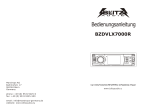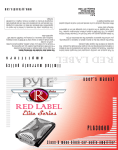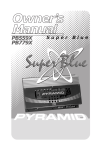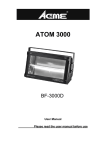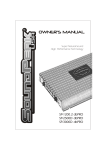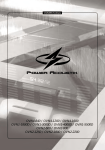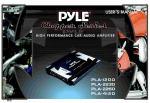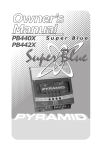Download Blitz Audio BZA-3000D Car Amplifier User Manual
Transcript
Class-D mono block MOSFET neon car audio amplifier BZA-3000D user’s manual limited warranty policy a m p l i f i e r s All Blitz products are carefully constructed and thoroughly tested before shipment. Products purchased in the USA are warranted to be free of defects in material and workmanship for two (2) years from the date of purchase. This warranty is limited to the original retail purchase. Should the product fail due to factory defects in material or workmanship, your unit will be repaired or replaced at the sole discretion of Blitz. To obtain warranty service you must first call our Consumer Return Hotline number at (718) 236-6948 to obtain a Return Authorization number. This R.A.# must appear on the outside of your package and on all paperwork relating to your return. When returning a product to us for warranty service it must be carefully packed and shipped prepaid to: R.A.# Blitz Service Center 1600 63rd Street Brooklyn, NY 11204 You must also include the following items: • A copy of your sales receipt or other proof of purchase • A brief letter indicating the problem you are experiencing • include in your letter your return address, daytime phone number, and R.A. number • also include a check or money order for $18.00 for return shipping, handling, and insurance, or provide your Visa/MC number with expiration date. Our obligation under this warranty is limited to the repair or replacement of the defective unit when it is returned to us prepaid. This warranty will be considered void if the unit was tampered with, improperly serviced, or subject to misuse, neglect, or accidental damage. www.blitzaudio.com INTRODUCTION... Thank you for purchasing the Blitz Class-D amplifier. Rest assured you have purchased a quality product designed and engineered to give you many years of uncompromised musical service.The Blitz Class-D amplifier has been designed using the latest in electronic technology available today. This is due to the noise introduced into the signal by the switching speed of the power supply, which must be filtered out of the audio signal. The power supply incorporated into Blitz amplifier is a DC to DC switching power supply designed to have adequate headroom for even the most demanding peak and dynamic range found on today's CDs and recording. This mono subwoofer amplifier is the result of advanced high speed switching technology that overcomes the less-efficient Class-D design. the Blitz Class-D amplifier reflects your true appreciation for powerful bass reproduction in the mobile environment. This amplifier is designed for low-frequency information only and it is not capable of reproducing any mid/high-frequency information. table of contents general features 2 features and specifications 3-4 system wiring 5-6 BZA-3000D BZA-3000D amplifier and installation 7 protection circuitry and troubleshooting 8 general features BZA-3000D 2400W Mono Block MOSFET Digital Power Amplifier · Mono Block Subwoofer Amplifier · 1 Ohm Stable · MOSFET Power Supply · PWM (Pulse-Width-Modulation) System · Glass Epoxy PCB · Gold Plated RCA Inputs for Line Input & Bypass Output. · Gold Plated Terminals for Speaker Output and Power Input. · Thermal, Overload and Short Protection · Variable Sub-sonic Filter (15Hz~40Hz, 24dB/Octave) · Variable Low-pass Filter (20Hz~250Hz, 24dB/Octave) · Phase Control 0-180 degree · Remote Bass Control · Input Impedance : 10K Ohms · Soft Turn On/Off · Advanced Protection Circuitry · S/N Ratio:>90dB · Heavy Duty Power Coated Heatsink · NEON Light · Dimensions: 10.9"(W) x 2.67"(H) x 15"(L) 2 fC lea sas t- Du Mr OeN sO B aL OnC Kd A Mc PoL InF ItE rR oB Zl As- 3 0 0 0 D BZA-3000D 6 3 fC lea sas t- Du Mr OeN Os B LaO nC Kd A McP oL InF ItE rR oB Zl As- 3 0 0 0 D BZA-3000D Mono channel amplifier Class-D design power supplies crossover low pass filter high pass subsonic filter output power @14.4v DC,50Hz RMS Power at @4 Ohms Stiffly regulated PWM power supplies. MOSFET switches maintain RMS Power at @2 Ohms rated power over a wide range of battery voltages. RMS Power at @1.3 Ohms Adjustable from 20Hz to 250Hz with a slope of 24dB per octave.This Maximum Power Outputs allows for the adjustment of the upper point of the frequency bandwidth and the respective subwoofer. frequency response input impedance Adjustable from 15Hz to 40Hz with a slope of 24dB per octave.This allows Low-frequency information for subwoofer only.High efficient power for the attenuation of frequencies that are mostly inaudible and cause unnecessary strain on the amplifier. protection circuitry remote dash-mount gain control input sensitivity power supply voltage Protection against thermal, overload and short circuit conditions. This amplifier come complete with a compact remote GAIN CONTROLLER which can be conveniently mounted on or under the dashboard of your car. 400W MONO 800W MONO 1200W MONO 2400W MONO 20Hz-250Hz(-+3dB) 10K Ohm 250mV~4V Adjustable 14.4V DC Neg.ground(10.5-16V) min speaker Impedance 1 Ohm T.H.D S/N ration 0.1% >90dB fuse dimensions (W x H x L) mm inches 4 40A x 2 276x67.8X381 10.9 x 2.67 x 15 system wiring Class-D MONO BLOCK AMPLIFIER BZA-3000D SIGNAL INPUT AND BYPASS OUTPUT CONNECTION BZA-3000D head unit 5 system wiring Class-D MONO BLOCK AMPLIFIER BZA-3000D POWER INPUT CONNECTION BZA-3000D 6 amplifier and installation mounting Find a suitable location in the vehicle to mount the amplifier Make sure there is sufficient air flow around the intended mounting location wiring tips Bolt the amplifier to the mounting surface. Connect the power ground terminal to the nearest point on the chassis of the car. Keep this ground wire less than one meter (39") in length. Use 4 gauge wire. Connect the remote terminal to the remote output of the head unit using 14 gauge. Connect an empty fuse holder within 300mm (12") of the battery and 4 gauge or larger high quality cable from this fuse to the amplifier location. Make sure there is no fuse in this fuse holder. Then make the connection to the "BATT" connection on the amplifier. If multiple amplifiers are being used, use cables (each with its own fuse at the battery) or a *0 or a *2 cable from the fuse holder at the battery to a distribution block at or near the amplifier's location. fuses Connect all line inputs and outputs using high-quality RCA-RCA cables. Insert fuse(s) at the battery fuse holder(s) Recheck all connections before powering up. Set all level controls to their least sensitive positions and set all crossover controls, switches, etc., To the desired frequency or position. Once the system is powered up, set the volume control on the head unit to about the 2 o'clock position, and then set all the amplifiers' level controls for maximum output level. Further fine tuning of the various controls may be necessary to obtain the desired results. 7 troubleshooting Before removing your amplifier, refer to the list below and follow the suggested procedures. Always test the speaker and their wires first. Amplifier will not power up Check for good ground connection. Check that remote DC terminal has at least 13.8V DC. Check that there is battery power on the terminal. Check all fuses. Check that Protection LED is not lit. If it is lit, shut off amplifier briefly and then repower it. High hiss or engine noise(alternator whine) in speakers. Disconnect all RCA inputs to the amplifier(s)- if hiss / noise disappears, then plug in the component driving the amplifier and unplug its inputs. If hiss / noise disappears, go on until the faulty / noisy component is found. It is best to set the amplifier's input level as insensitive as possible. The best subjective S/N ratio is obtainable this way. Try to drive as high a signal level from the head unit as possible. Protection LED comes on when the amplifier is powered up. Check for shorts on speaker leads. Check that the volume control on the head units is turned down low. Remove speaker leads, and reset the amplifier. if the protection LED still comes on, then the amplifier is faulty. Amplifier(s) gets very hot. Check that the minimum speaker impedance for that model is correct. Check for speaker shorts. Check that there is good airflow around the amplifier. in some applications, an external cooling fan may be required. Distorted sound Check that the level control(s) is set to match the signal level of the head unit. Check that all crossover frequencies have been properly set. Check for shorts on the speaker leads. High squeal noise from speakers. This is always caused by a poorly-grounded RCA patch cord. 8









